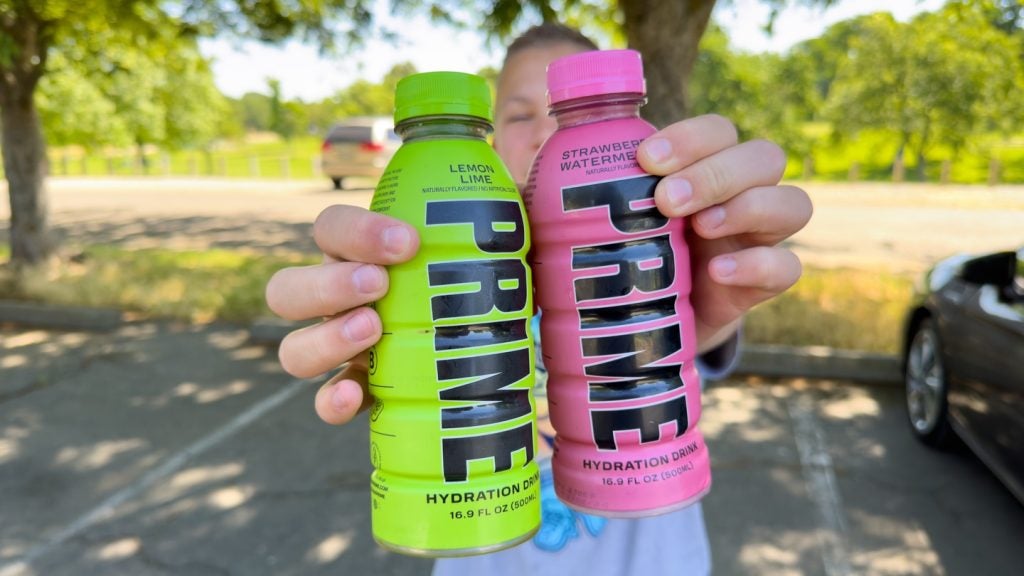Prime, the viral hydration and energy drink developed by internet celebrities Logan Paul and KSI in 2022, claims it is set to surpass $1.2bn in annual sales this year, as the company positions itself as “the fastest growing beverage in history”.
The beverage, operated by product development firm Congo Brands, is celebrating its one billionth bottle sold, just two years after launch.
For context, Red Bull, arguably the product that inaugurated the energy drinks category in the 1980s, turned over $10.38bn and sold 11.5 billion cans in 2022.
Prime Hydration – a marketing marvel
Prime has also benefited from significant visibility across multiple channels – from the founders’ own social media and countless retail distribution deals to high-level sponsorships across the sports and entertainment space.
Over the past year, the label has become a sponsor of soccer teams Bayern Munich, FC Barcelona and Arsenal and the Ultimate Fighting Championship (UFC) mixed martial arts series, among others, displacing previous sponsors such as Gatorade and Coca-Cola. In April, the brand also signed a six-figure deal with Base Sports Group to expand the drink’s presence in youth sports.
GlobalData’s Q3 2023 global consumer survey reveals 41% of consumers view endorsements by celebrities or organisations as “essential” or “nice to have” when deciding upon product purchases.
Prime has also found its niche in a crowded market. Congo Brands’ Alani Nu targets older females, Red Bull targets white-collar workers, Monster targets lower-income blue-collar workers and Ghost targets performance and lifestyle-focused consumers, while Prime has leveraged gamification and youthful social media platforms such as TikTok to narrow in on the under-20 market.
“Prime Hydration has successfully resonated with fitness-orientated youths in part due to its focus on social media marketing,” says Saad Farooq, trends and themes analyst at GlobalData. “The company has effectively used platforms like Instagram and TikTok to reach and engage with young audiences, capitalising on its partnership with KSI and Logan Paul to promote its products through sponsored content on their YouTube channels.”
The Prime hashtag on TikTok has now garnered some 16.1 billion views.
Prime, however, has also had its fair share of PR setbacks. In July, a US senator called on the FDA to probe Prime’s energy drink over its “eye-popping” levels of caffeine, while prominent fitness influencers have dismissed its hydration drinks as Logan Paul and KSI’s “most profitable scam yet”.
Positioned in part as a functional beverage, Prime’s hydration drinks contain magnesium and potassium, but miss out on electrolytes such as calcium, sodium, chloride and phosphate. They also lack glucose, the presence of which is important for the proper absorption of electrolytes.
Thanks @LeslieBonci @DWntrition for weighing in on Prime Drinks and how they aren't appropriate as a sports drink due to their composition via @Forbeshttps://t.co/d8egxn6JgJ
— Toby Amidor, MS RD (@tobyamidor) November 7, 2023
Prime’s growth nevertheless appears to have been unaffected by some less-than-ideal publicity.
Energy drinks' energetic growth
Prime is also benefitting from the booming energy drinks market: in 2022, the energy drinks category grew at a five-year compound annual rate of 9.02%, while the soft drinks sector as a whole grew at a five-year rate of 2.93%.
Other energy drinks such as health-focused Celsius Holdings, are also capitalising on this upsurge. In Q2, Celsius’ revenue grew 112% year-over-year to $326m – on top of 137% year-over-year revenue growth in 2022 – making it one of the fastest-growing businesses in the world. The company is now expanding its reach beyond the US market with plans to launch in Europe and Canada in 2024.
The category is expected to continue on its upward growth trajectory, with GlobalData forecasting a five-year rate of 10.93% in 2025.
What’s driving the energy drinks boom? Mark Astrachan, an analyst at Stifel Nicolaus, weighs in: “People are in fact sleeping less, they’re looking for more energy, they want to do more with their day, and these provide caffeine and, sure, it’s the same as basically a coffee in terms of caffeine but it’s a different delivery mechanism.”
“The value proposition here also helps, if you think about the price of a coffee at Starbucks today versus what it was ten years ago. It’s probably double where it was. Go in and drink your fancy latte and it’s probably six or seven dollars before you get out the door.”
“Energy drink prices have gone up like a lot of other categories but you can still get a Monster for under $3. You can get a Celsius for under $3 if you get it on promotion, which is how a lot of people buy this – it’s two for $5.50, two for $6, or three for $7. The value proposition here is also greater.”
Our signals coverage is powered by GlobalData’s Thematic Engine, which tags millions of data items across six alternative datasets — patents, jobs, deals, company filings, social media mentions and news — to themes, sectors and companies. These signals enhance our predictive capabilities, helping us to identify the most disruptive threats across each of the sectors we cover and the companies best placed to succeed.









